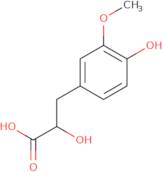Vanillactic Acid
CAS: 2475-56-1
Ref. 3D-CAA47556
| 2mg | Descontinuado | ||
| 5mg | Descontinuado | ||
| 10mg | Descontinuado | ||
| 25mg | Descontinuado | ||
| 50mg | Descontinuado |
Informação sobre produto
- 2-Hydroxy-3-(4-hydroxy-3-methoxyphenyl)propans?ure
- 2-Hydroxy-3-guaiacylpropanoic acid
- 3-(3-Methoxy-4-hydroxyphenyl)lactic acid
- 3-(4-hydroxy-3-methoxyphenyl)-Lactic acid
- 3-Methoxy-4-hydroxyphenyllactic acid
- Acide 2-hydroxy-3-(4-hydroxy-3-méthoxyphényl)propano?que
- Benzenepropanoic Acid, Alpha,4-Dihydroxy-3-Methoxy-
- Benzenepropanoic acid, α,4-dihydroxy-3-methoxy-
- Lactic acid, 3-(4-hydroxy-3-methoxyphenyl)-
- Vanillactic acid
- Ver mais sinónimos
- Vanillyllactic acid
- b-(4-Hydroxy-3-methoxyphenyl)lactic acid
- beta-(4-Hydroxy-3-methoxyphenyl)lactic acid
- α,4-Dihydroxy-3-methoxybenzenepropanoic acid
DL-Vanillactic acid lithium salt hydrate is a molecule that can be used to diagnose and monitor prolactin levels. It has been shown to be more sensitive than the RIA method in determining serum prolactin levels, with a detection limit of 0.1 ng/mL. DL-Vanillactic acid lithium salt hydrate has also been shown to react with urine samples and increase the concentration of vanillactic acid, which is a metabolite of dopamine. The presence of vanillactic acid in urine may indicate an excess of dopamine, which can lead to carcinoid syndrome or cancer. DL-Vanillactic acid lithium salt hydrate can also be used as a diagnostic tool for other molecules such as serotonin, histamine, and catecholamines.





